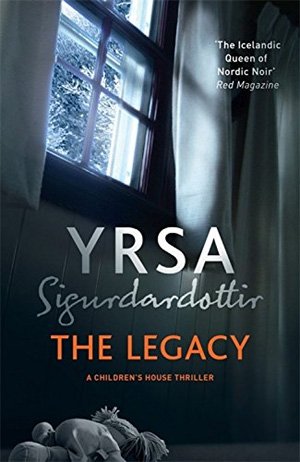 Written by Yrsa Sigurdardottir, translated by Victoria Cribb — Icelandic author Yrsa Sigurdardottir is already well known thanks to her series featuring the lawyer-turned-sleuth, Thora Gudmundsdottir. With The Legacy, the writer is striking out in a new direction with a series based around a children’s home in Reykjavik. And our story opens in 1897, at this very home. Two little boys and their sister are before the board, and decide the siblings should be adopted by separate families. That’s the heartrending set-up. What happens next is brutal.
Written by Yrsa Sigurdardottir, translated by Victoria Cribb — Icelandic author Yrsa Sigurdardottir is already well known thanks to her series featuring the lawyer-turned-sleuth, Thora Gudmundsdottir. With The Legacy, the writer is striking out in a new direction with a series based around a children’s home in Reykjavik. And our story opens in 1897, at this very home. Two little boys and their sister are before the board, and decide the siblings should be adopted by separate families. That’s the heartrending set-up. What happens next is brutal.
We jump to the present day, with mother-of-three Elisa woken in the night by her daughter, who’s adamant they have an intruder. Her husband is away so Elisa begrudgingly gets up to have a look around. Before she knows it, an assailant has pinned her to the floor and is wrapping her head in gaffer tape. He forces the business end of a vacuum cleaner pipe down her throat and sucks the very life out of her. The author wins a point for ingenious death, and scores a couple more later on.
The murder investigation is led by Huldar, a bit of a wag, whose minions include sharply dressed Rikhardur and power chick Erla. One reason Huldar’s a wag is because he’s recently slept with Rikhardur’s wife. Another is that he has no interest in Erla. And the third is that he’s also slept with Freyja, though he gave her a false name and snuck off in the morning. Freyja, in turn, works at the children’s home and she’s involved in the case because the victim’s daughter witnessed the murder – albeit from her hiding place under the bed.
Awkward.
Freyja thought she’d never have to deal with Huldar again, but now she has to button down her anger and help him and his team by interviewing the nine-year-old girl. And Huldar, well.. beneath his sheepish embarrassment, he still fancies his chances with Freyja.
Even more awkward.
Across Reykjavik, there’s Karl Petursson. He’s a nerdy chemistry student with just two friends – Halli and Borkur. He likes the odd spliff and, as a ham radio fanatic, Karl is part of a dying breed. He lives alone thanks to the recent death of his adoptive mother. His brother has moved to the US. Circumstances and low self-esteem have given him a pessimistic if not depressing view of life. One day, Karl starts receiving a strange series of numbers, read out in Icelandic, on his radio set. He begins noting them down, thinking he can crack the code.
The translator must be commended, because the text reads fluidly. The author brings us very close to the investigation. Procedural minutiae – how children are interviewed, the postmortem, gathering CCTV footage, digital forensics and more – make the police work seem as real as can be, though never dull or overwrought. That’s because all the while we are brought very close to the characters as well. What they see, hear and smell; their ideas; and what they think of each other – it’s all delivered quickly, clearly and with a wry sense of humour. One or two moments of brutal honesty will make you laugh out loud.
Perhaps, however, they get a little too close, and we notice that they’re missing something. Their petty quibbles and dismissiveness grows tiring. They don’t seem to express any happiness at all, and no hope for themselves or anyone else. It’s hard to bond to any of them. Until the final third, the most sympathetic character is Molly, the dog that Freyja is looking after.
It’s only when Karl’s place in the murderer’s plan is revealed that we can really engage. As clever as poor Karl thinks he is, everything is set against him and you can’t help but root for the fellow simply because of the injustice of it all. His downbeat outlook proves to be entirely correct.
Despite all their hard work, the police haven’t made much headway. Maybe Huldar’s too worried about what Freyja thinks of him to really focus on the clues. At one point, Karl leaves a message with the police about the strange radio codes. The author dangles that there and it’s gloriously excruciating to read the passage where they pass Karl off as a crackpot when he actually has valuable information. Lovely work by the author.
The conclusion is even more astounding, thanks to her white-hot plotting. They don’t have snakes in Iceland, nor deserts, but Yrsa’s storyline cuts a twisting pattern like a sidewinder crossing the Mojave. The book is a whodunnit, and a whydunnit at the same time. All the while, you’ll have the vague idea that everything goes back to those three kids split up by the children’s home, but it’s hard to guess who the culprit is or exactly what’s motivating them.
Unlike many Nordic noir novels, the climate and remote, rugged landscapes play no role in The Legacy. It’s similar to the TV programme Case in that respect, and shares the theme of adoption. It’s a thoroughly good read, and if you enjoyed Case you’ll like this too.
Hodder & Stoughton
Print/Kindle/iBook
£9.99
CFL Rating: 4 Stars








